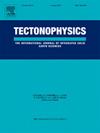火成岩热导率的成分控制及南极地壳热导率模型
IF 2.6
3区 地球科学
Q2 GEOCHEMISTRY & GEOPHYSICS
引用次数: 0
摘要
模拟通过岩石圈的热通量需要精确估计热导率,但很少有地区有足够的估计来约束热模型。相比之下,全球地球化学数据库拥有大量样本,但缺乏物理性质估计。在这项研究中,我们将1053个全球分布的样品的导热系数测量与已知的化学成分结合起来,包括48个来自南极洲的新分析,以建立导热系数与主要元素组成、模态矿物学和规范矿物学之间的经验关系。尽管残差存在偏差,但所有成分模型都导致类似的失配(~ 0.4 W m−1 K−1),95%的样品在测量电导率的±20%范围内。然后,我们将这种电导率-成分关系应用于PetroChron南极洲数据库,以预测6995个火成岩原岩的导热性。我们预测南极地球化学样品95%的热导率估计值范围为1.78 ~ 3.19 W m−1 K−1,平均值为2.49±0.31 W m−1 K−1。这些经验关系提供了一种对岩石导电性进行合理估计的方法,可用于改善已知岩石成分的冰川和冰盖下的热通量估计。本文章由计算机程序翻译,如有差异,请以英文原文为准。
Compositional controls on the thermal conductivity of igneous rocks and a model for the conductivity of Antarctic crust
Modelling heat flux through the lithosphere requires accurate estimates of thermal conductivity, yet few regions have sufficient estimates to constrain thermal models. Global geochemical databases in contrast, have numerous samples, but lack physical property estimates. In this study, we combine thermal conductivity measurements on 1053 globally-distributed samples with known chemical composition—including 48 new analyses from Antarctica—to develop empirical relationships between conductivity and major element composition, modal mineralogy and normative mineralogy. Despite a skew in the residuals, all compositional models result in similar misfit (∼0.4 W m−1 K−1) with 95 % of samples within ±20 % of measured conductivities. We then apply this conductivity-composition relationship to the PetroChron Antarctica database to predict the thermal conductivity of 6995 igneous protoliths. We predict 95 % of thermal conductivity estimates for Antarctic geochemical samples range from 1.78 to 3.19 W m−1 K−1, with an average of 2.49 ± 0.31 W m−1 K−1. These empirical relationships provide a way to produce reasonable estimates of rock conductivity that can be used to improve heat flux estimates beneath glaciers and ice sheets where the composition of the rocks is known.
求助全文
通过发布文献求助,成功后即可免费获取论文全文。
去求助
来源期刊

Tectonophysics
地学-地球化学与地球物理
CiteScore
4.90
自引率
6.90%
发文量
300
审稿时长
6 months
期刊介绍:
The prime focus of Tectonophysics will be high-impact original research and reviews in the fields of kinematics, structure, composition, and dynamics of the solid arth at all scales. Tectonophysics particularly encourages submission of papers based on the integration of a multitude of geophysical, geological, geochemical, geodynamic, and geotectonic methods
 求助内容:
求助内容: 应助结果提醒方式:
应助结果提醒方式:


